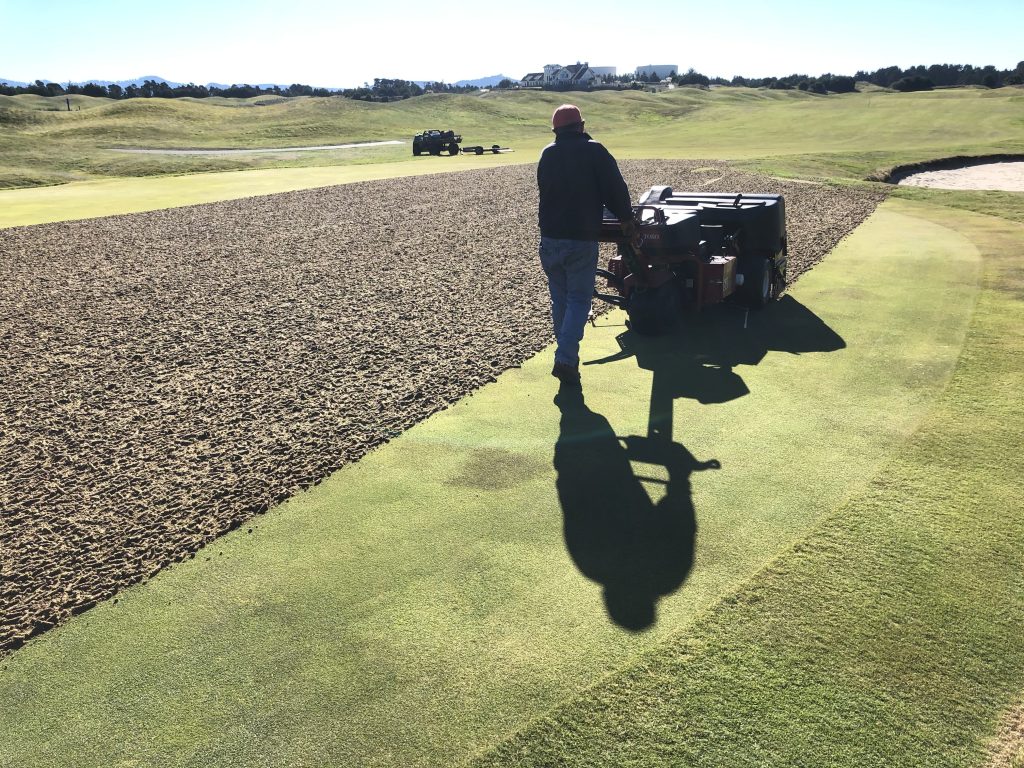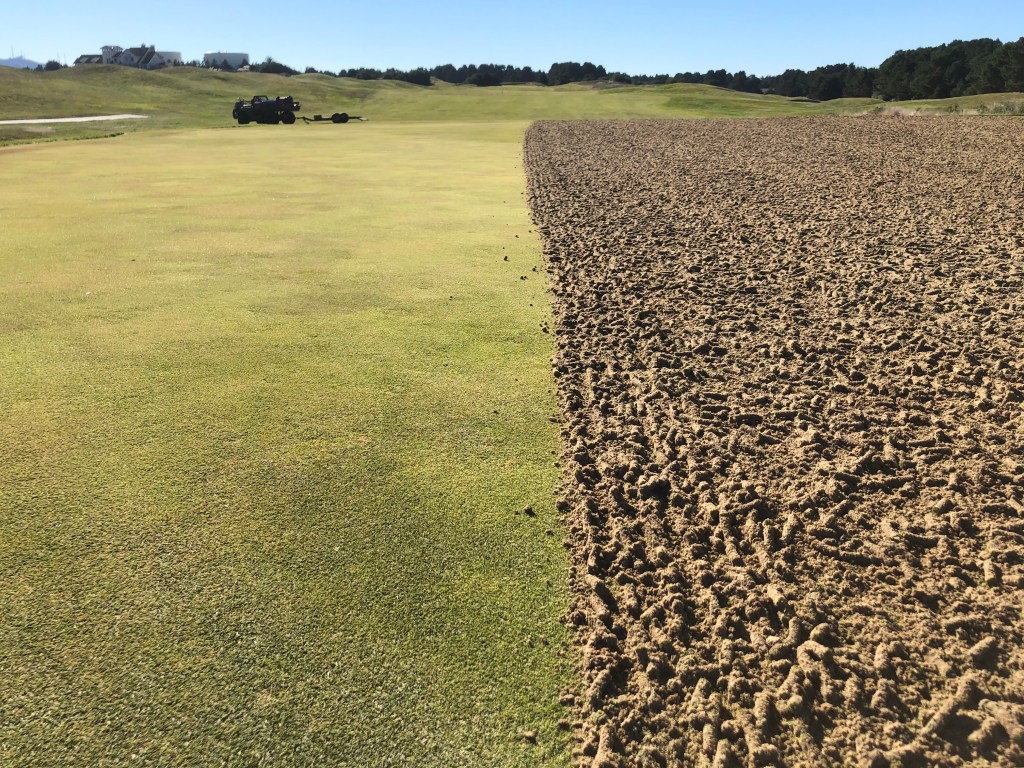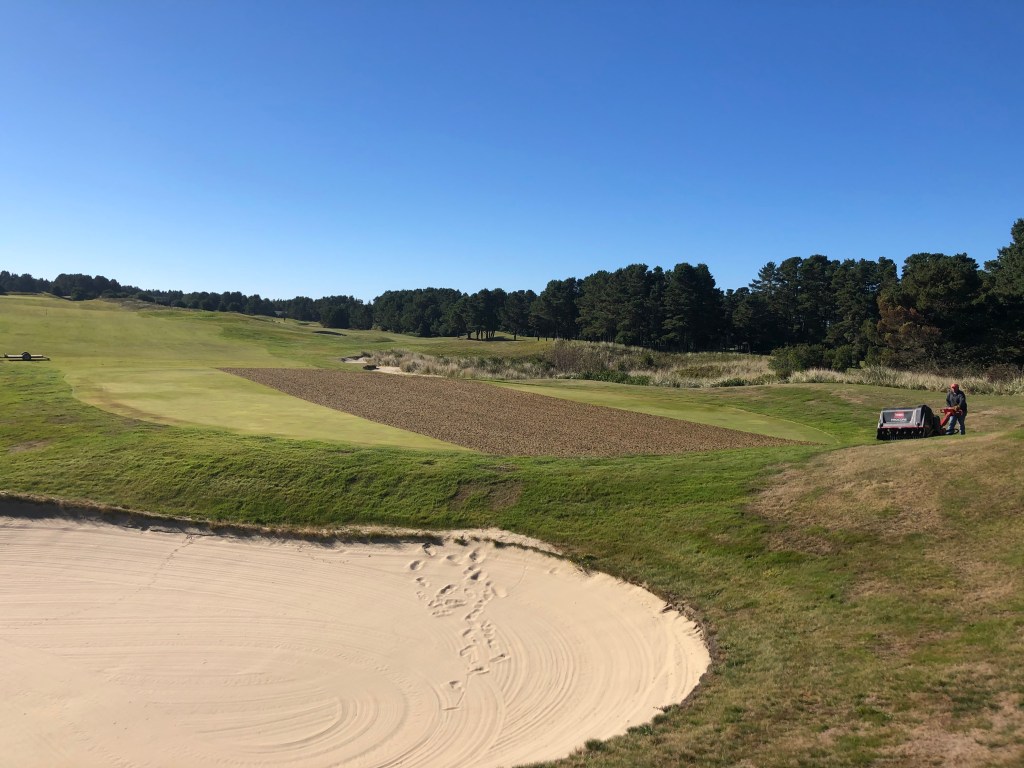As a golfer, the sight of aerification on the course can feel like an inconvenience. The mess, the temporary disruptions in play, and the slower-than-usual greens are enough to spark frustration for anyone looking to enjoy a smooth round. But for golf course superintendents & course maintenance team, including us at Sandpines Golf Links, aerifying the turf is a vital practice to ensure long-term course health and the quality of play.
The tension between golfers and superintendents is real, but understanding the benefits of aerification can help alleviate the frustration.

The Science Behind Aerification: Why It’s Essential for Turf Health
At its core, aerification is all about creating the best possible environment for turfgrass to thrive. Whether on the fairways, tees, or greens, healthy grass is essential for a great golfing experience. Turfgrass, like all living things, has parts that deteriorate over time, including the leaves, sheaths, crowns, and roots. As these plant parts age, they break down into thatch — a layer of decomposing organic material that accumulates on the soil’s surface.
While thatch can seem harmless, it creates a variety of problems for the plant. Thatch acts as a barrier, hindering water infiltration, nutrient absorption, and gas exchange — critical functions for plant health. Over time, it can also become a breeding ground for pests and pathogens, making the turf vulnerable to disease. When plants are unable to drink, eat, or breathe properly, they become stressed and less resilient, leading to weaker turf that can’t withstand heavy foot traffic or environmental stressors.
Aerification directly addresses this issue by disrupting the thatch layer and ensuring that the soil receives essential nutrients, air, and water. In essence, it’s a form of deep care for the course’s grass, allowing it to continue growing strong and healthy.

The Aerification Process at Sandpines Golf Links: A Strategic Approach
At Sandpines Golf Links, we understand that golfers want to enjoy a pristine course, free from interruptions. That’s why our superintendent employs a thoughtful and strategic approach to aerification to balance course health and golfer convenience.
We use a combination of techniques to manage thatch and improve the playing surface:
- Vertical Mowing: By vertically mowing the turf with specialized blades, we can remove thatch before it becomes problematic. This process lifts the decaying material from the canopy and brings it closer to the surface, where it can be properly dealt with.
- Sand Topdressing: After vertical mowing, we apply a thin layer of sand to the turf. Not only does this smooth out the surface, creating a more consistent playing experience, but the sand also acts as a diluting agent for the thatch, improving the soil structure and promoting healthier grass.
- Venting: Venting involves poking small holes into the soil profile without removing cores. This helps improve water infiltration and gas exchange, both crucial for turf health, and aids in relieving compaction. Venting is typically followed by sand topdressing, which further enhances the process.
- Plant Growth Regulation: To help control the amount of thatch produced, we use plant growth regulators. These slow down grass growth, minimizing the volume of organic matter that accumulates on the surface, while still maintaining the health and appearance of the turf.
- Spoon Feeding Fertilization: Instead of large, sporadic doses of fertilizer, we apply small, regular feedings to ensure the turf receives a consistent level of nutrients. This “spoon feeding” technique helps maintain balanced plant growth and reduces the overall need for aerification, resulting in healthier turf with less disruption to golfers.
- Pest Management: Regular treatments of fungicides and wetting agents help protect the turf from disease and ensure optimal moisture retention, which in turn enhances the plant’s ability to compete with natural environmental stressors.

The Results: Healthy Turf, Happy Golfers
While aerification may seem like a hassle, it’s actually one of the most important steps in ensuring Sandpines Golf Links remains a top-tier course for golfers. By regularly aerifying, topdressing, and using innovative turf management techniques, we provide a healthy, resilient playing surface that resists pests, recovers quickly from damage, and offers a consistent, smooth experience on every hole.
For golfers, this means better turf conditions throughout the year — greens that roll smoothly, fairways that are firm but forgiving, and tees that provide solid footing. In short, it’s all about creating the best possible conditions for play, ensuring that every round at Sandpines Golf Links is an enjoyable one.

Aerification Makes For Better Play At Sandpines Golf Links
Aerification is a critical part of turf management at Sandpines Golf Links. While the process may be a temporary inconvenience, its long-term benefits far outweigh the short-term disruption. By keeping our course in top condition, we’re ensuring that every golfer enjoys the best possible playing surface. So the next time you see the team at Sandpines out on the course performing aerification, remember: it’s for the health of the turf — and the enjoyment of your game.
